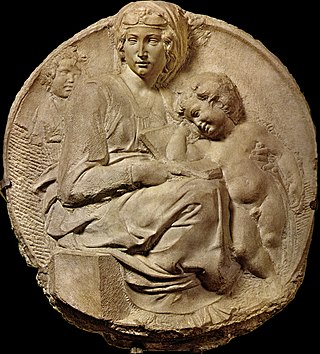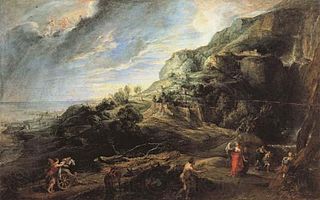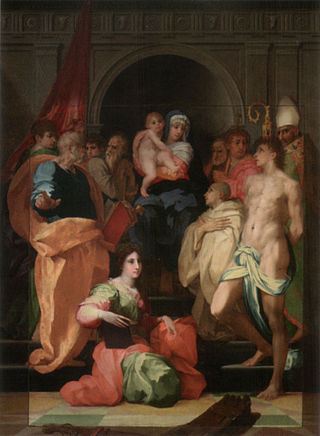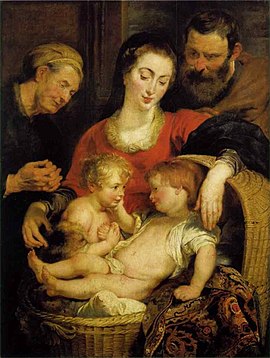History
The oldest mentions of the work are recorded to the Villa del Poggio Imperiale in 1654–1655, then from 1697, at the Palazzo Pitti in the "Parrot Room." The work was registered in various other rooms until, in 1799, French inspectors sent the work to Paris, where it was stored at the Dijon Museum of Fine Arts. The painting remained there until the end of 1815 and was returned to Florence the following year.
A copy of the work was found in a private collection in Vienna, with the signature of "L. Burchard" and of greater quality than the Florentine version. Another, more modest, copy can be seen in the Galleria di Palazzo Spinola in Genova, which is attributed to Jacob Jordaens.
Description and style
The basket that gives the work its traditional name is, in reality, the wicker cradle in which the baby Jesus rests, watched over by Mary and Joseph. He tenderly caresses the face of John the Baptist, recognizable by the fur coat of a desert hermit. Behind him stands his mother, Saint Elizabeth. Joseph's mature, but not old, age suggests he was made to seem more like a saint.
Inspired by Italian works, the work is marked by the influence of Parmigianino, in the face of Mary. The fluid disposition of the people, the mastery of color and effects of brushstrokes, and the characterization of the people (like the resplendent hair, the opacity of Joseph's beard, and the material effect in the carpet under the baby Jesus) make this a small masterpiece that exemplifies the best work of Rubens.
It is one of the better compositions on this religious subject realized around 1615, along with the painting at the Wallace Collection in London, which is dated to c. 1614.

The Palazzo Pitti, in English sometimes called the Pitti Palace, is a vast, mainly Renaissance, palace in Florence, Italy. It is situated on the south side of the River Arno, a short distance from the Ponte Vecchio. The core of the present palazzo dates from 1458 and was originally the town residence of Luca Pitti, an ambitious Florentine banker.

Justus Sustermans, Joost Sustermans or Suttermans, his given name Italianised to Giusto, was a Flemish painter and draughtsman who is mainly known for his portraits. He also painted history and genre paintings, still lifes and animals.

Ridolfo di Domenico Bigordi, better known as Ridolfo Ghirlandaio was an Italian Renaissance painter active mainly in Florence. He was the son of Domenico Ghirlandaio.

The Madonna della Seggiola or The Madonna della Sedia is an oil on panel Madonna painting by the High Italian Renaissance artist Raphael, executed c. 1513–1514, and housed at the Palazzo Pitti Collection in Florence, Italy. Although there is documentation on its arrival to its current location, Palazzo Pitti, it is still unknown who commissioned the painting; however, it has been in the Medici family since the 16th century.

Andrea del Sarto was an Italian painter from Florence, whose career flourished during the High Renaissance and early Mannerism. He was known as an outstanding fresco decorator, painter of altar-pieces, portraitist, draughtsman, and colorist. Although highly regarded during his lifetime as an artist senza errori, his renown was eclipsed after his death by that of his contemporaries Leonardo da Vinci, Michelangelo, and Raphael.

The Lamentation over the Dead Christ is a painting of the common subject of the Lamentation of Christ by the Italian Renaissance painter Pietro Perugino, executed in 1495 and now in the Galleria Palatina of Palazzo Pitti, Florence, Italy.

The Pitti Tondo is an unfinished marble relief of the Virgin and Child by Michelangelo in round or tondo form. It was executed between 1503 and 1504 while he was residing in Florence and is now in the Museo nazionale del Bargello in Florence.

The Portrait of Alvise Cornaro is a portrait by the Venetian painter Tintoretto, showing the man of letters Alvise 'Luigi' Cornaro. Datable to around 1560–1565, it was acquired by Leopoldo de' Medici and is now in the Galleria Palatina in Florence. For the time between the 1698 and 1829 inventories, it was mis-attributed to Titian.

The Four Philosophers is an oil painting on panel painted in 1611–12 by Peter Paul Rubens. It is now held in the Galleria Palatina of the Palazzo Pitti in Florence.

The Resurrection of Christ, The Easter Tomb or The Triumph of Christ over Death and Sin is a painting by Peter Paul Rubens, executed c. 1616. It entered the collection of Ferdinando de' Medici, Grand Prince of Tuscany between 1713 and 1723 and is now in the Galleria Palatina of the Palazzo Pitti in Florence.

The Peasants' Return From The Fields is a c. 1640 painting by Peter Paul Rubens. It arrived in Florence in 1765 and is now in the Galleria Palatina in Florence.

Odysseus on the island of the Phaecians is a landscape painting by Peter Paul Rubens, dating to around 1630–1635. It shows Nausicaa and her maids discovering Odysseus on Phaecia. It is now in the Galleria Palatina in Florence.

Panciatichi Assumption is a painting created c. 1522–1523 by the Italian Renaissance artist Andrea del Sarto. It is housed in the Galleria Palatina of Palazzo Pitti, Florence, Italy.

Passerini Assumption is an oil-on-panel painting executed in 1526 by Italian Renaissance artist Andrea del Sarto. It is housed in the Galleria Palatina of Palazzo Pitti, Florence, Italy.

Madonna della Scodella is an oil painting on panel by Antonio da Correggio, dated from 1528 to about 1530 and preserved at the Galleria nazionale di Parma.

The Bartolini Tondo is a tempera-on-panel painting by the Italian Renaissance artist Filippo Lippi. 135 cm in diameter, it is also known as Madonna with the Child and Scenes from the Life of St Anne or Madonna and Child with the Birth of the Virgin and the Meeting between St Joachim and St Anne. It is now in the Galleria Palatina in the Palazzo Pitti in Florence. The work is mentioned in the Palazzo Pitti inventories in 1761, which mention it as being stored or displayed in the "soffitte" or attics.

The Dei Altarpiece is an oil on panel painting by Rosso Fiorentino, commissioned in 1509 by the Dei family and completed in 1522. It is now in Florence's Galleria Palatina, whilst the Uffizi holds a preparatory drawing which may be the original idea for the work.
This page is based on this
Wikipedia article Text is available under the
CC BY-SA 4.0 license; additional terms may apply.
Images, videos and audio are available under their respective licenses.
















